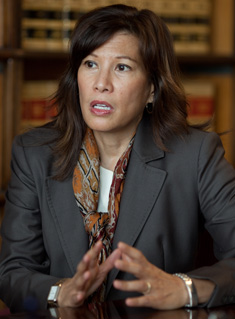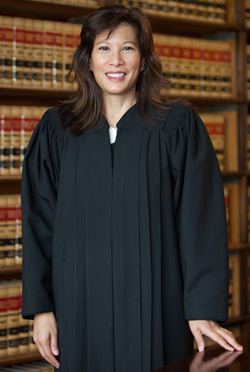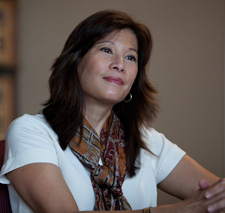Still awed by the judicial branch’s top job,
the new chief justice digs in
By Nancy McCarthy
Staff Writer
 |
Tani Cantil-Sakauye said she was shocked to be nominated as California's next chief justice. Like the Academy Awards, "It is an honor to be nominated." PHOTOS BY ROBERT DURELL
|
When Tani Cantil-Sakauye received a phone call from the governor’s office in July asking if she’d consider nomination as California’s next chief justice, she was flabbergasted. In fact, she was speechless and the caller finally asked, “Do you know what we’re talking about?”
“And I said, ‘Yes, I do know what you’re talking about.’ . . . It truly is like the Academy Awards,” she said. “It is an honor to be nominated. It really is.”
Months later, on the eve of being sworn in by Gov. Schwarzenegger, the associate justice for the Third District Court of Appeal admits she’s still awed by her new job. With 20 years on the bench and two years on the Judicial Council under her belt, she feels comfortable handling administrative duties but says she’ll tread cautiously on the legal side, listening to and learning from her six new colleagues. She takes an historical perspective in approaching the job, and makes clear she likes to get the facts before making decisions, will not act unilaterally, doesn’t want to recycle old or unsuccessful ideas and will advocate strongly on behalf of California’s courts.
Cantil-Sakauye, 51, doesn’t bring a particular agenda to the new job, but has four priorities as a result of her time on the Judicial Council: additional judgeships, recruitment and retention of qualified judges and justices, statewide adoption of the electronic case management system and construction of new court facilities.
But the foremost issue in the near future, she says, is operating costs. Like every public agency, the judicial branch has been hard hit by financial cutbacks and faces a $315 million deficit in this fiscal year. Unlike other branches, it has sustained what Cantil-Sakauye calls a double whammy: budget reductions accompanied by an absence of funding for court operations, including increased caseloads, greater population and greater public need.
“Courts are places of last resort, so to cut them is to do great harm to the public where it has no access to justice and no ability to enforce the laws that are passed by the executive and legislative branch,” she said.
In a wide-ranging interview in her spacious, book-lined chambers overlooking the Sacramento skyline, the petite chief justice-elect offered her thoughts on some of the challenges she’ll face when she succeeds Ronald M. George Jan. 3. The chief justice, she says, wears three hats — one with the associate justices on the bench itself, one as the chair of the judicial branch and the third as the face of California’s judiciary.
Any major changes to the courts, she says, will be made by the Judicial Council, and only with input from its many constituents. She’ll listen to complaints by the Alliance of California Judges, a group of trial court judges who believe their concerns, particularly about how court funds are allocated, have been largely ignored by the Judicial Council. “The trial courts want a say in how to weather the storm, and that’s fair,” Cantil-Sakauye said. She insisted the Judicial Council tries to be as inclusive as possible, but adds, “We in this business live by the motto that reasonable minds can differ.”
 |
Cantil-Sakauye lists four key initiatives: additional judgeships, recruitment and retention of qualified judges and justices, statewide adoption of the electronic case management system and construction of new court facilities
|
She expects to follow George’s lead on writing decisions in the toughest cases herself and shares his often-stated frustration with the burdens of capital cases and the death penalty, an issue she characterizes as staggering. Although she shares some of George’s concerns about California’s initiative process, the criticism is tempered by her belief that “this is the people’s right to access. . . . It’s laborious, it’s frustrating, but I think it’s part and parcel of California’s political heritage.”
A Sacramento native, Cantil-Sakauye was born in 1959 to farmworker parents. Her Filipino/Portuguese dad, Clarence, worked the pineapple farms in Hawaii before coming to California, and her mother, Mary Gorre, was part of a Filipino farmworker family who moved up and down the state with the crops.
She has vivid memories of a humble childhood, growing up with a sister and two brothers, picking tomatoes on weekends, short on material goods but always well fed. For her first nine years, the family’s house was in a downtown alley, next door to a brothel, in a neighborhood that was later condemned for redevelopment. The Cantils moved to Land Park, “a very nice neighborhood in town, although I didn’t know it at the time.” She did know that her family was the only ethnic family in the neighborhood. “That I knew. I don’t know how I knew it, but at 9, you just do.” They continued their “very, very humble” lifestyle, with “no frills, no junk food, no gifts, nothing of any kind.”
Her best friend, with whom she remains close, lived differently; her home had white carpets, oil paintings and Chinese furniture and she wore emerald earrings. “It didn’t dawn on me that we were different because she spent most of her time at my house wanting to eat white rice with milk and sugar on it,” she recalled.
Cantil-Sakauye attended a local junior college before enrolling at UC Davis, graduating with a degree in rhetoric in three years. She went to law school, also at UC Davis, when teachers and others she respected suggested she do so, particularly because she did well on the debate team. She waitressed for years at A. J. Bumps, first at its Freeport restaurant and later in Davis, and dealt blackjack at Stateline. Because a clerkship at a law firm after her first year of law school didn’t include a salary, she and a law school friend headed to Harrah’s at Lake Tahoe, where they lived “like church mice in a beat-up apartment, hardly any electricity, we ate at the casino on the discounted food and we rode bikes to work.”
Cantil-Sakauye joined the Sacramento district attorney’s office in 1984 and began a fast professional rise as deputy legal affairs secretary and then deputy legislative secretary to Gov. Deukmejian, who named her to the municipal bench at 30. She was a superior court judge from 1997-2004, handling civil and criminal assignments and presiding over the county’s first domestic violence court. She has served as an associate justice for the Third District Court of Appeal in Sacramento since 2005.
 |
Warm and outgoing, Cantil-Sakauye brings the values of a humble upbringing to California's top judicial job
|
Warm and down to earth, Cantil-Sakauye said descriptions of her as California’s first Filipina chief justice are “both nice and a bother.” As a longtime lawyer and judge, she said she simply works hard and long ago lost any self-consciousness about her heritage and her gender. “Sometimes it comes as a surprise that I am described that way,” she says, “because I don’t think of myself in that way.”
On the other hand, she added, her family provides a source of strength, and their sacrifices have given her opportunities and a life they did not have. And she feels empowered by other women lawyers, grateful for those who paved the way.
Five days before George announced he would not seek re-election, Cantil-Sakauye submitted her application to succeed the presiding judge of her bench, only because, she says, no one else seemed interested. Already nervous about that prospect and the changes it might bring to her life, Cantil-Sakauye says she never included herself in the pool of possible replacements for George. Indeed, when Schwarzenegger asked her what she thought about taking the job, “I turned to him and I said, ‘I don’t know anyone who thinks of that. No one dreams this big.’”
Asked if George mentioned the possibility of succeeding him, she was adamant. “No. No. No. No. I didn’t have an inkling. None.”
Cantil-Sakauye said she had to remove herself from the “sheer bright light of it all” and consider whether taking the job was the right thing to do, “given the time in my life and given how I had never considered it before.” Her children, Hana, 14, and Clare, 12, will remain in school in Sacramento, with her husband, Mark Sakauye, a retired Sacramento police lieutenant. Cantil-Sakauye will live part time in San Francisco and hopes to continue to attend her daughters’ volleyball and basketball games, iPad in hand.
Asked to recall a decision that stayed with her, Cantil-Sakauye smiled at the memory of Hertzberg v. Plumas County. A constitutional regulatory taking case, the matter dealt with whether or not cows can roam free in the field. The case became known as the “cow poop” case, she laughed, explaining that she liked it because it reflected the beauty of California’s diversity. “It was sort of a microcosm of living in California; they still have that issue in Plumas County where in Los Angeles County, they’re arguing about trade secrets. It was fun.”
The cows won.
The case also called on Cantil-Sakauye’s sense of humor, which she places in the top three requirements for success as a judge. The others: a sense of courage and self-confidence.
She admits her name, a combination of her maiden and married names, is “a mouthful” and she is typically addressed as Judge Cantil, or Judge, or Justice or Your Honor. (It’s pronounced Con-TEEL-Saw-ka-OO-yay.) Few people use her full last name; she was already a judge when she married at 35. As for the full name, “No one bravely goes down that road,” she laughed.
Although her life may become exceedingly complicated when she moves to the Supreme Court next month, her name will be simpler. She’ll simply be called, “Chief.”